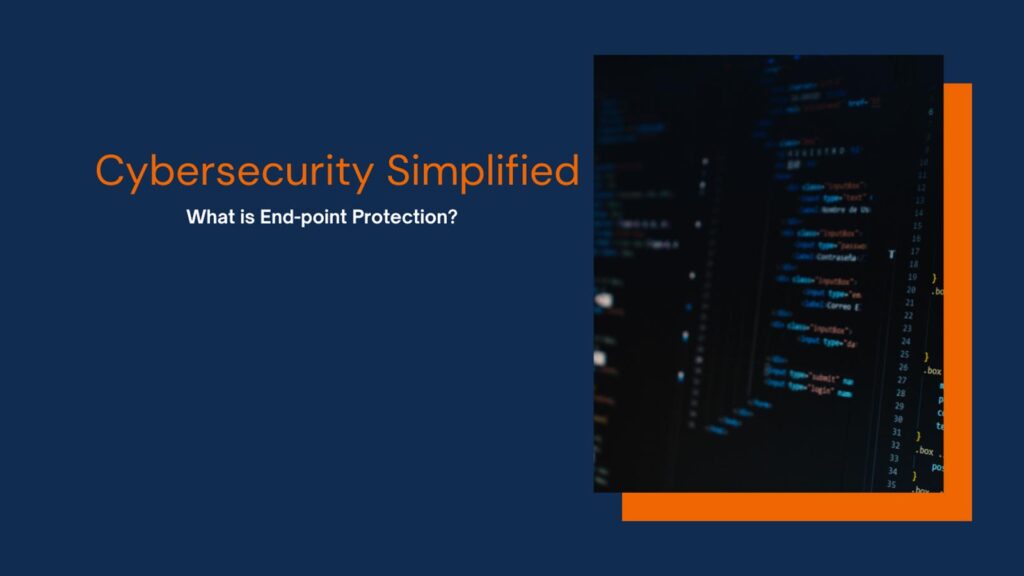Ready to understand endpoint protection technology trends and solutions in 2025? We bring you “Cybersecurity Simplified”, a novel effort to simplify the basic terminologies, technologies, techniques, concepts, and insights related to cybersecurity. In 2025, several key trends will continue to reshape endpoint security management and technology integration with clouds, containers, and Kubernetes. Building on the momentum of recent years, advancements in artificial intelligence (AI) and machine learning (ML) will further enhance threat detection and response capabilities. Additionally, the emphasis on Zero Trust Architecture (ZTA) will remain a critical strategy in safeguarding organizational networks. As cyber threats evolve, these trends—and others—will play a pivotal role in defining the future of endpoint security in the year ahead.
With our dedicated ‘Cybersecurity Simplified’ program, we’ll break down key terms, technologies, techniques, concepts, and insights to make cybersecurity easier to understand. Today, we will discuss endpoint security or endpoint protection solutions.
Let’s start.
Introduction to Endpoint Protection Solutions
Endpoint protection, more popularly referred to as endpoint security” involves enterprise-level practices and technologies used to safeguard devices that connect to a network—such as laptops, smartphones, tablets, and desktops—against cyber threats. These devices are often vulnerable to attacks because they serve as entry points into an organization’s network, making them prime targets for hackers. According to Intent Market Research, the endpoint security segment is projected to hold the largest share of the cybersecurity market. This growth is driven by the increasing adoption of endpoint protection technologies that offer key benefits, including enhanced patch management, prevention of insider threats, web content filtering, AI-powered threat mitigation, and overall cybersecurity optimization. Furthermore, companies in this space have developed advanced solutions that are gaining significant market traction, further accelerating the growth of the endpoint security sector.
4o mini
Before we define the protection benchmarks, let’s define an endpoint.
An endpoint refers to any device that allows an employee or system to connect to a corporate network. As the adoption of Bring Your Own Device (BYOD) policies grows and the number of connected devices expands with the rise of the Internet of Things (IoT), the number of potential entry points to a network has increased significantly.
Common types of devices considered as endpoints include:
- ATMs and POS
- IoT-enabled smart devices
- Industrial control systems and machinery
- Laptops and desktops
- Medical equipment
- Mobile phones and tablets
- Printers and other peripheral devices
- Servers and workstations
- Wearables, such as smartwatches
As more devices become interconnected, ensuring the security of these endpoints is critical to protecting an organization’s network from cyber threats.
Endpoint security involves not only detecting and defending against external threats like malware, ransomware, and phishing attacks but also addressing risky user behaviors that could lead to vulnerabilities. This includes preventing actions that may inadvertently compromise a device, such as downloading malicious software or accessing unsecured websites. By protecting endpoints, organizations can significantly reduce the risk of a successful attack and ensure the integrity of their overall network security.
Here are the top definitions of endpoint protection, published by the CyberTech leaders.
#1 Cloudflare
Cloudflare says endpoint protection or endpoint security is the process of defending any device that is connected to a network. Endpoint security frameworks run on two models:
- Client-server model
- SaaS model
According to Cloudflare, organizations can leverage endpoint protection software to enforce security policies, detect threats, block ongoing attacks, and prevent data breaches. Since endpoints are directly connected to internal corporate networks, endpoint protection is a critical element of overall network security, helping to safeguard both devices and the network they access.
#2 Cato Networks
Cato Networks provides a detailed overview of the key components in the endpoint security frameworks.
According to Cato Networks, endpoint security is applied to an “endpoint” or networking node of a computing device. The key components include:
- Threat intelligence
- Anti-virus or anti-malware
- Endpoint Protection platforms (EPPs)
- Endpoint detection and response (EDR)
- Data Loss Prevention (DLP)
- Network Level Defenses (for example, firewalls and intrusion detection and prevention systems/ IDPS)
Endpoint security solutions protect against common threats such as:
- Exploits of vulnerabilities through web browsers
- Social engineering attacks via email, which lead to the opening of malicious files or links
- Compromised USB devices
- Threats originating from shared file drives
- The use of unsecured applications
Advanced Endpoint security solutions providers like Sysdig fill the endpoint security gaps in the containers and Kubernetes (K8) ecosystems. How?
Traditional Endpoint Detection and Response (EDR) solutions were designed for host-based environments, which makes them inadequate for modern cloud-native applications and containerized infrastructures. These solutions only provide a broad list of processes running on the host, without visibility into which processes are tied to specific containers. This leaves security teams scrambling to identify which container in a Kubernetes cluster is under attack, often relying on event alerts that lack critical context, data evidence, and rapid access to the affected containers for effective mitigation.
To address this gap, Sysdig introduced Rapid Response—the first runtime security solution that combines EDR functionality with deep visibility into the containers and K8 environments. Rapid Response is built for the cloud-native world, allowing security teams to quickly identify, investigate, and mitigate threats directly within containers, offering enhanced context and real-time access for fast, efficient incident response.
#3 Fortinet
Fortinet says, “Endpoint security is the process of protecting devices like workstations, servers, and other devices (that can accept a security client) from malicious threats and cyberattacks. Endpoint security software enables businesses to protect devices that employees use for work purposes or servers that are either on a network or in the cloud from cyber threats.” In its detailed definition, Fortinet clearly differentiates between antivirus and endpoint security solutions.
Antivirus software is crucial in helping businesses detect, remove, and prevent malware from compromising devices. These solutions are typically installed directly on endpoint devices, such as laptops, desktops, mobile devices, and network servers. While antivirus software focuses on safeguarding individual devices, endpoint security solutions offer broader protection by securing the entire business network, ensuring comprehensive defense against cyber threats.
#4 SentinelOne
The makers of Singularity XDR and Singularity Endpoint, SentinelOne defines endpoint security somewhat differently.
It says an endpoint is a point of interaction within a communications network. Unlike components that simply transmit or redirect data across the network, an endpoint is where data originates or is received. Essentially, it refers to any device that can connect to a network and send or receive information. These devices can include computers, smartphones, servers, and other networked systems.
#5 Sophos
Sophos, the leading provider of Unified Endpoint Management (UEM) solutions, defines Endpoint security as the process of overseeing and securing all devices that access or store organizational data. A robust endpoint management strategy ensures continuous protection and optimal security for all devices, working around the clock to maintain a strong security posture. It involves regularly assessing, assigning, and monitoring access rights for every endpoint across the organization to ensure comprehensive control and protection.
Why Do Companies Require Endpoint Security Solutions?
As cybersecurity concerns continue to rise in response to the growing number of internet-connected devices, businesses face an increasing challenge in protecting their networks. The COVID-19 pandemic accelerated the shift to remote work, leading to a surge in the use of mobile devices, laptops, desktops, and other endpoints outside traditional corporate environments. These devices, while essential for remote operations, have become prime targets for cyberattacks, as they serve as potential entry points into corporate networks beyond the security of firewalls.
Endpoint protection is crucial not only for user devices but also for workstations and servers, which remain vulnerable to attacks from hackers and cybercriminals. In modern organizations, any device connected to the corporate network, whether remotely or on-site, is considered an endpoint that requires protection. As these devices connect from outside the corporate firewall, they present new avenues for malicious actors to breach an organization’s defenses.
The rise of hybrid and remote work since the pandemic has further expanded the attack surface, increasing the number of entry points that cybercriminals can exploit. As a result, endpoint protection has become more critical than ever to safeguard against threats and ensure that remote and on-site devices remain secure from potential cyberattacks.
This growing concern underscores the importance of adopting robust endpoint security measures to defend against the evolving landscape of cyber threats.
Benefits of Endpoint Protection
1. Improved Visibility
Endpoint security solutions typically offer centralized management across enterprise devices, providing comprehensive visibility into an organization’s IT assets. With this enhanced visibility, businesses can better identify vulnerabilities, track device activities, and detect potential threats before they escalate.
2. Malware Prevention and Containment
Endpoint protection solutions are specifically designed to detect, prevent, and contain malware threats. Modern solutions, such as Endpoint Protection Platforms (EPP) and Endpoint Detection and Response (EDR), are equipped to handle advanced malware that employs evasion techniques, which are often effective against traditional antivirus software.
3. Access Management
Effective access management is a core feature of endpoint protection, especially with solutions like Zero Trust Network Access (ZTNA). ZTNA restricts access to corporate resources based on verified identities and device compliance. By ensuring that only authorized and secure devices can connect to the network, organizations minimize the risk of data breaches and unauthorized access.
4. Secure Remote Work
As remote and hybrid work arrangements become the norm, ensuring the security of remote devices is critical. Endpoint protection solutions continuously monitor and secure devices, even when they are not directly connected to the corporate network. This helps prevent the spread of malware from infected remote devices to other corporate assets.
5. Data Loss Prevention (DLP)
Endpoints are often targets for data theft, especially in cases of ransomware or data exfiltration. Endpoint security solutions that incorporate DLP capabilities monitor for malicious activity such as unauthorized data transfer or encryption, ensuring sensitive information is protected before data loss or theft occurs.
6. Improved Compliance
With evolving regulations requiring stringent data protection measures, endpoint security plays a critical role in maintaining compliance. Endpoint security solutions help protect data at rest and in transit, provide the necessary reporting features, and facilitate audits to ensure that organizations adhere to regulatory requirements.
7. Enhanced Productivity
Cybersecurity incidents—such as malware infections or data breaches—can significantly disrupt operations. By preventing these threats, endpoint security solutions allow businesses to maintain smooth operations, minimizing downtime and improving overall productivity for employees and security teams alike.
8. Cost Savings
Data breaches and other cyberattacks can be costly, not only in terms of direct financial loss but also from reputational damage and legal liabilities. By preventing attacks or minimizing their impact, endpoint protection solutions can help organizations avoid the substantial costs associated with a security breach.
Best Practices: Setting up Endpoint Protection in 2025
To maximize the effectiveness of an endpoint protection program, businesses should adopt a set of best practices. These strategies ensure comprehensive security and resilience against evolving cyber threats.
1. Converged Security Architecture
Endpoint security should be part of an integrated, converged security architecture. Rather than relying on disparate point solutions, centralizing security management allows for better context sharing and faster incident response. A unified approach reduces visibility gaps and enhances overall security effectiveness.
2. Data Loss Prevention (DLP)
As endpoints store and process sensitive data, Data Loss Prevention (DLP) is essential for any endpoint security program. DLP solutions help monitor and control data migration or movement, ensuring that sensitive information is not accessed, leaked, or stolen—whether through malicious actors, forced extortion, or accidental exposure.
3. Patch Management
Many endpoint vulnerabilities arise from outdated or unpatched software. Ensuring that patches and updates are applied promptly is essential to mitigating security risks. Implementing automated patch management processes helps prevent attackers from exploiting unpatched vulnerabilities, particularly in devices that are remote or in BYOD environments. Zero Trust Network Access (ZTNA) solutions can help enforce patch management by restricting access for unpatched devices.
4. Comprehensive Support for All Devices
Organizations need an endpoint security solution that supports all types of devices—whether company-issued or personal devices under BYOD policies. This includes not just laptops and smartphones but also Internet of Things (IoT) devices and remote systems. Effective endpoint protection must cover a diverse and increasingly complex network of devices, regardless of their location or ownership.
5. Machine Learning and AI for Threat Detection
With the rapid evolution of cyber threats, traditional methods of threat detection are often not sufficient. Machine learning (ML) and artificial intelligence (AI) are becoming indispensable in modern endpoint protection solutions. AI-powered security tools can detect and respond to emerging threats faster than traditional systems by identifying patterns and anomalies that might indicate malicious activity.
6. Zero Trust and Account Security
Zero Trust principles focus on limiting access based on the principle of “never trust, always verify.” Every access request is evaluated individually to ensure that users and devices have the appropriate privileges. When combined with strong account security measures, such as multi-factor authentication (MFA), Zero Trust helps prevent unauthorized access and limits the impact of compromised endpoints.
7. Employee Education
End-user behavior is often the weakest link in an organization’s security chain. Employees may unknowingly click on phishing links, download malicious attachments, or share sensitive data insecurely. Regular cybersecurity training and awareness programs are vital to reduce the risk posed by human error. Educating employees on safe practices and potential threats strengthens an organization’s overall endpoint security posture.
8. Defense in Depth
To minimize the risk of a single security failure leading to a breach, organizations should implement a defense-in-depth strategy. This involves using multiple layers of security controls across the endpoint, network, and cloud environments. For example, combining firewalls, intrusion detection/prevention systems (IDPS), and endpoint security tools helps ensure that if one control fails, others can provide backup protection.
Top 5 Endpoint Protection Trends for Businesses in 2025
As cyberattacks on endpoint devices continue to rise, global spending on cybersecurity has also surged, shaping the latest trends in the field. With cybercriminals becoming more sophisticated in their methods and tools, businesses must evolve their approach to endpoint security to effectively combat growing risks, particularly around malware. The COVID-19 pandemic accelerated remote work and digital transformation, prompting new trends in cybersecurity.
Recommended: Predictions Insights 2025: 5 Most Advanced Types of Cyberattacks Every CISO Should Know
Here are the top 5 trends in endpoint protection in 2025 for businesses, reflecting the latest developments in the post-pandemic world:
1. Extended Detection and Response (XDR)
What It Is:
Extended Detection and Response (XDR) integrates various security technologies into a unified system that enhances threat detection and response across endpoints, networks, and servers. XDR provides a holistic view of an organization’s security posture, allowing for a more comprehensive response to complex threats.
Why It Matters:
XDR’s ability to correlate data from multiple sources helps organizations detect advanced threats faster and respond more effectively. It also reduces the time to identify and contain threats, minimizing potential damage to endpoint devices and the broader network.
2. Zero Trust Security Model
What It Is:
The Zero Trust model operates on the core principle of “trust no one, verify everything.” It continuously authenticates and authorizes both users and devices, regardless of their location within or outside the corporate network.
Why It Matters:
Zero Trust helps mitigate the risks of unauthorized access and data breaches by assuming that no one, whether inside or outside the organization, should be trusted by default. By constantly verifying identities and device security, this model is an effective defense against malware and cyberattacks.
3. AI and Machine Learning for Threat Detection
What It Is:
Artificial Intelligence (AI) and Machine Learning (ML) are increasingly being used to detect and respond to cyber threats in real time. These technologies can process vast amounts of data, identify patterns, and detect anomalies that traditional security systems might miss.
Why It Matters:
AI and ML provide advanced, automated threat detection capabilities, enabling faster identification of potential attacks and reducing the reliance on manual intervention. By simulating human intelligence, these technologies enhance endpoint security by proactively identifying emerging threats and responding without delay.
4. Unified Endpoint Management (UEM)
What It Is:
Unified Endpoint Management (UEM) solutions allow businesses to centrally manage and secure all endpoint devices, including mobile devices, laptops, desktops, and Internet of Things (IoT) devices. UEM provides a unified approach to endpoint management by applying consistent security policies, updates, and compliance checks across all device types.
Why It Matters:
As businesses adopt a wider range of devices in 2025, including mobile and IoT devices, UEM helps ensure that all endpoints are secure and compliant. A centralized management system streamlines the process of securing and monitoring devices, providing better control over an organization’s security posture.
5. Cloud Security Integration
What It Is:
Cloud security integration refers to the practice of combining endpoint protection with cloud-based security measures. As businesses increasingly adopt hybrid work models and move critical data to the cloud, securing both endpoints and cloud environments becomes essential.
Why It Matters:
Cloud security integration addresses the growing vulnerabilities associated with remote work and cloud-based data storage. By integrating endpoint protection with cloud security practices, businesses can ensure that data and applications hosted in the cloud remain protected from cyber threats while facilitating secure data transfer and storage.
Conclusion
Endpoint Protection in 2025 will be a major topic of discussion about the CIOs and CISOs. The rise of cyberattacks on endpoint devices will continue, forcing businesses to rethink their cybersecurity strategies with AI and Automation. As cybercriminals become more sophisticated, adopting advanced technologies such as XDR, Zero Trust, AI, and UEM can significantly improve endpoint protection. Additionally, integrating cloud security measures and staying ahead of the evolving threat landscape will help organizations safeguard their endpoints and sensitive data in 2025 and beyond.
Latest CyberTech News: Semarchy, Apgar Partner to Speed SAP S/4HANA Migrations
To share your insights, please write to us at news@intentamplify.com





